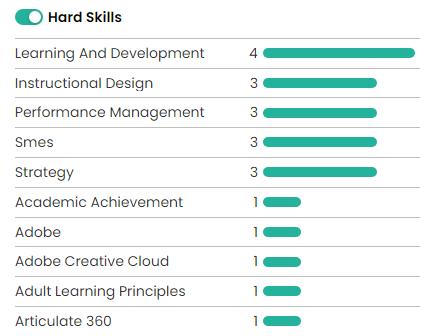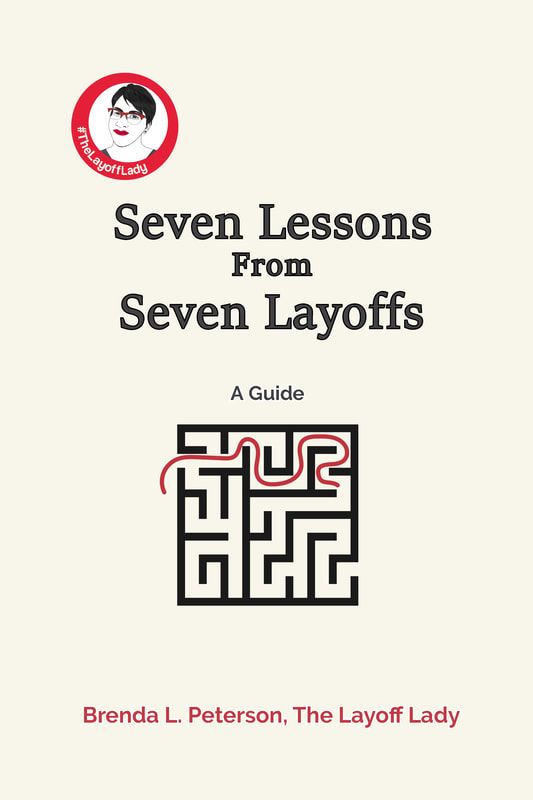|
By Brenda L. Peterson, The Layoff Lady So Many Openings!Depending on your chosen field, and your desired work arrangements, there are a lot of jobs for which you could apply. While remote work availability gives us many more work options, figuring out how to prioritize open positions can be overwhelming. Here is my process for evaluating open roles and prioritizing those which I will submit an application. Searching for Available JobsAs of this article's original publication date, I just searched on Indeed.com for the job title Training Specialist. This search generated these results:
By any stretch of the imagination, I cannot apply for 631 jobs this week. Time to Apply and Available TimeOnce I decide to apply for a given role, I take about 30 minutes to research the company, customize my resume, and complete my formal application. In a given week, there are 7 days, which is 168 hours. There are not enough hours in a week for me to apply for that many jobs. Even if I somehow managed not to eat, sleep, or do even the most basic self-care, I could only apply for 336 jobs. Closer to the realm of feasibility, if I decided to dedicate a full 40 hours per week solely to applying for jobs, I could apply for 80 jobs—but definitely not well. There are also so many other valuable activities (meeting people and professional development being two of the most important) to be done during job searching that this is probably not the best way to spend 40 hours. Working this long and this hard can also put you on the fast track to burnout. Even dedicating 20 hours solely to applying for jobs, possibly meaning you could apply for 40 jobs in a given week, is most likely overkill. More Is Not Necessarily BetterThe more jobs I try to apply for in rapid succession, the less effective I am. While applying for jobs is in some respects, a numbers game, it’s not as easy as applying to all the jobs and knowing that one will work out. This strategy often causes people to waste time applying for roles where they are not very qualified. A better strategy is to prioritize jobs that are the best match for your skills and what you want and focus on applying for those well. Instead of solely applying for jobs, spend time building your skills, making new connections, and planning for contingencies. In any given week, my goal is usually to apply for three jobs. However, if I see several great opportunities or have not searched for a job in a while, I may apply for as many as six. Beyond that, though, my application quality suffers. Prioritizing ApplicationsTo apply for jobs well, you need to determine the best way to prioritize your applications. Instead of the “spray and pray” approach, think through what you want and apply with more purpose. This approach favors quality over quantity and will help you focus your efforts on where you can get better overall results for your time investment. Step 1: Know Key Characteristics of What You WantEarly in your job search, it’s essential to do at least a little soul-searching and be able to articulate what you want. This may include revisiting your values, identifying your strengths, and thinking about the work you want to do. For example, earlier career Brenda would have a list something like this on what she wanted from a role:
Having a stated list of preferences, and continuing to hone it as you learn more, is your first step in determining which jobs to target. Step 2: Narrowing Your SearchLet's go back to those 631 search results from my Training Specialist searches. By adding additional search parameters, we can narrow our results to jobs that more specifically meet our specified criteria: Starting with those 43 roles in Omaha:
Starting with those 588 remote jobs:
Step 3: Quick Job Listing ReviewNow that I have a more reasonable number of jobs to go through (12 and 45--57 total), I start to do a cursory review of the short descriptions of each role. No
Yes
I have now reduced the number of jobs that interest me to 31 roles. Step 4: More Detailed Job Listing ReviewNow that I have those 31 jobs in Teal, I look more closely at the following:
I remove jobs where I am not eligible. This includes the following:
I remove jobs with anything that might be a dealbreaker for me. This includes the following:
For the remaining jobs, I give them an initial rating of 1-5 stars and make notes on any areas I might want to explore further. I now have 18 jobs in Teal. Step 5: A Little More ResearchNext, I investigate a few things outside of the immediate job descriptions.
Now, I have 13 jobs In Teal. Step 6: Customize a Resume and Prepare to ApplyFrom the 13 jobs I have listed, I will apply for the jobs I'm most excited about and continue to reassess other openings listed. I will also add, remove, reprioritize, and take notes on specific roles as needed. Learn More
0 Comments
By Brenda L. Peterson, The Layoff Lady Your Salary RequirementsMost of us work so we can pay for our lives. When you are job searching, it’s important to determine your target salary range to make your job search more effective. Having this information will help you prioritize which jobs to apply for and help you have those early salary conversations. Let’s look at a few strategies for answering the question, “What are your salary requirements?” Start With Your Target RolesFirst, ensure you’ve done the requisite amount of soul-searching to determine what you want to be next in your career. Have a list of what you want to do, possible job titles, relevant skills, core responsibilities, daily activities, focus areas, types of companies, and industries. Having these details on your desired job will help as you start to do salary research. The DisclaimerWhile I feel comfortable discussing various financial and insurance concepts, I do not currently hold a license or any certification that deems me inherently qualified to give financial advice. The information provided here is intended to be used for educational purposes only. Sometimes, the core challenge is knowing how a system generally works, the terms used to describe what you’re asking about, and where to go for additional help. My goal for this article is to share information to guide you as you navigate the murky waters of job searching. I hope my personal experiences can help you cut a path through the wilderness as you try to figure out your next steps. Feel free to take my recommendations or not. Whatever you do, double-check my facts--and everyone's purported facts, for that matter. This is your life, and you will care more about your financial and healthcare decisions than anyone else. Use this information as a starting point for further research as you ultimately decide what’s right for you. Identify Your PrioritiesNow that you understand your target job and what that looks like, think about what you value in a job. For example, some may prioritize having a specific job title, receiving tuition reimbursement money to earn their next credential, and opportunities for a promotion within the company. Another person may prioritize having interesting work while also having schedule flexibility, the ability to work remotely most days, and low health insurance premiums. Still another person may prioritize alongside colleagues in an office, having the opportunity to mentor new employees, and finding a job they can keep for the next 20 years. Think about what is the most important to you. In addition, think about what you value in an employer. Working for a non-profit, government entity, start-up, family business, or Fortune 500 company will have salary, benefit, job security, and total compensation-related implications. Overall, think about what matters to you, and be aware of the salaries that align with your overall job preferences. Factors That Influence Your Target Salary RangeWhen considering your salary requirements, I suggest using a range instead of one specific number. Let’s look at strategies for determining your target salary range. Here are numbers you might have in mind that could impact your range:
I suggest the salary range you share with potential employers includes the lower number that is the minum salary you would happily accept and the maximum number is what you'd be really excited about. What Companies Are PayingKnowing what companies are paying for what you do should also factor in to your target salary range. Here are a few strategies for finding out more: Search For Openings in Pay Transparency StatesTake these steps to find out what open positions are paying:
Research Your Job Title and Geographic LocationMany websites have salary information. Two that come highly recommended by recruiters are Salary.com and Payscale.com. In fact, Salary.com has a Know Your Worth calculator where you can add details like your job title, location, education level, and years of experience and see the impact each factor has on your potential market value. Ask AroundFind out from other job searchers, recruiters, and hiring managers what salaries companies are paying for specific roles. You can also inquire with professional development organizations to see if there are industry or job-specific studies available that include salary-related information. Confounding FactorsHere are a few factors that might make this process challenging:
Learn More
By Brenda L. Peterson, The Layoff Lady Eye on the Prize: Getting the InterviewThere are a lot of opinions on how to interact with employers early in the hiring process. They include everything from sending a basic “I applied” email to off-the-wall rom-com level gesture like sending the hiring manager a cake with your resume attached to the inside of the box. In this article, we’ll focus on using email to follow up after you have formally applied for the job. Regardless of your approach (and my overall follow-up recommendations are closer to the email than the cake end of the spectrum), stay focused on what you’re trying to accomplish. Remember, your goal at this point in the process is to get your application into the “must interview” pile. What Follow-Up Email Messages Will and Won't DoLet’s first set a few expectations on the impact sending a follow-up email message will have:
Like with most of the hiring process, there is no guarantee that you will get an interview for any given role. However, doing the right things consistently gives you a better chance of having a positive outcome. My Horror Story: Follow-Up Gone AwryOnce upon a time, I was the hiring manager for an instructional designer position. A person who I had never met, but who knew a colleague of mine, had a background in instructional design and was interested in the job. Through our shared colleague, that person (who I will now refer to as “the candidate”) ended up with my name and work contact information. What followed was an example of the worst-case scenario of a how a candidate reaching out to a hiring manager can actually be detrimental. From mid-December through the end of the calendar year, over the course of 10 business days, the candidate (who—reminder—I had never before interacted with in any way) contacted me 16 times via phone and email about the open position. I do not remember what all the candidate asked during each request (because blocking out awful memories is a real thing). I do remember one early request was asking how to apply for the job. Given that this role was with a technology company, and I needed someone who could work independently and solve problems, a candidate who wasn’t sure how to apply for the job through a pretty typical Careers webpage was not going to be a top candidate. In addition, after they managed to apply, they then called and also emailed the recruiter multiple times, again in the spirit of follow-up. The good news—we definitely knew the candidate’s name. The bad news (for them)—we knew for sure we were NOT going to interview them. Worst Practices: Job Application Follow-UpAs a hiring manager, here are the issues I’ve seen when people follow up on job applications:
Finding the Right People and Contact InformationRemember, typically the two people to follow up with regarding your job application are the recruiter and the hiring manager. The first challenge is figuring out who these people are, then getting their email addresses. In some cases, the name of the recruiter may be included on the job posting. Through using LinkedIn or the company website, you may be able to find a professional email address to use for them. You can also potentially do some digging through LinkedIn and find out the name of the recruiter through their LinkedIn posts. It could be little to no effort to find their email address, or a genuine project, to find out that detail about the recruiter. For hiring managers, some job listings will include the title of the hiring manager (who the position reports to), or even sometimes their name. Again, you may be able to use LinkedIn to find their contact information, or you may find the naming scheme a company uses (like firstname.lastname@companyname.com) to figure out their email address. You may also need to contact HR or a current employee to find out more, or there might be fee-based services you can use. When it comes right down to it, it is important for you to determine how much time and money you want to dedicate to finding this information. You also need to decide if the time you spend on this quest is worth the value you will gain from sending a follow-up message. It's your call. What To Include In Your Follow-Up EmailOnce you’ve identified the person to contact, and have their email address, think about what you’ll say in your message. Here are my recommendations on details to include:
How a Follow-Up Message Might LookSubject Line: Following Up on my Support Manager Application Body of the Message: Hi, Annette. I’m Esme Whitlock, and I'm sending you a quick message to introduce myself, and let you know I just applied for the Support Manager role with Super Cool Company. Because I have a background working in tech support specialist and help desk supervisor jobs in manufacturing companies, I think I am a great match for this position. As indicated in the job description, I have experience setting up a knowledge base using Super Cool Software and training new staff on using internal resources. I also enjoy hiring and training new associates and helping them grow their skillsets to meet performance goals. These skills, and my desire to grow in my career, drive my excitement for this role with Super Cool Company. If you’re interested in talking to me directly about the Support Manager role and my qualifications, please contact me via text/phone at 555-555-5555 or via email at myemailaddress@myemail.com. Thank you! Esme Whitlock 555-555-5555 myemailaddress@myemail.com https://www.linkedin.com/in/mylinkedin/ewhitlock Follow-up Email Timing and FrequencyThere are also various opinions on when to contact a potential employer and how many contacts to make. I suggest emailing once sometime between the day you apply and a week after you apply to briefly introduce yourself and get your name in front of the hiring manager and/or recruiter. If you decide you want to do a second message, I suggest waiting until a week or two after the first message and modifying the message so it is not just a repeat of the first message you send. Remember, you get to do whatever you want to do. Some hiring managers and recruiters may be very open to messages, and others might prefer to avoid being contacted. I believe reaching out one to two times with a few days in between contacts should show your interest without venturing into being way too much. Learn MoreBy Brenda L. Peterson, The Layoff Lady The Value of Professional NetworkingWhen it comes to job searching, professional networking is a critical component of success. Ideally, you make initial connections with people through LinkedIn (maybe even after meeting them in person or at an online group event). While this is a great start, there is value in building relationships beyond that initial connection. A 1:1 meeting can significantly strengthen a networking relationship and help you learn how you and your new connection can help one another succeed. About 1:1 Networking MeetingsSo what exactly is a networking meeting? Back in the day, I remember hearing people talk about doing "informational interviews." In short, if you were interested in having a particular job or working with a specific company, you would contact an organization or individual and ask if they would meet you for an informational interview. In this 1:1 meeting, which could take place via phone or in person, you might learn about the company, what they are looking for, skills to acquire, and more. It also allowed you to start to build a relationship with a company--or a possible advocate in the person doling out said information. Fast forward to now. Today, a networking meeting is typically between you and another person deciding to spend a half hour-ish together. This meeting, sometimes called a coffee chat, could happen virtually via Zoom or in person, often over coffee. If you're job searching, the typical focus will be on how to progress in your job search. Someone may agree to a networking meeting because you have things in common (like a field of work, background, professional goals), because they are generally committed to helping people when they are job searching, or because you have a mutual acquaintance to ask that person to meet with you to help you out. Networking Meeting = Informal InterviewWhenever you have an opportunity to meet one-on-one with someone, remember that you are taking part in a type of informal interview. Whenever I meet with someone in career transition, my goal is to help them figure out their next steps, offer advice (if they ask and are interested), and give them ideas on further steps they might take, including who they should speak with next While I go in with this idea, the amount of help I'll provide also depends on how this networking meeting goes. Ideally, we have a good, productive conversation, and I think to myself, "I totally want to help this person more." If the meeting goes well, I'll refer them to specific resources that might benefit them (like a networking group they might want to join, a company to check out, someone to follow on LinkedIn) and even put in a good word for them to have a networking meeting with someone else who might get them closer to their goals. In addition, if it goes REALLY well, this is a person who I'll refer to others for openings, pass on job opportunities, and maybe even hire someday. If the meeting doesn't go well, I'll share a few resources, but I may not be willing to help them as actively moving forward. Remember, any interaction you have with people will impact their desire to help you in the future. Types of Networking MeetingsHere are a few common types of networking meetings:
Networking Meeting Best PracticesHere are a few best practices for networking meetings:
The True Power of Networking MeetingsWhen people talk about how they "networked" into a new job, typically, that means they leveraged their initial connections to help make inroads with new contacts, who helped them get closer to a new position. The holy grail of networking meetings is when the person you meet with agrees to introduce you to someone else they know who could help you. That process repeats until you're talking to a hiring manager or influencer who can help you get an interview for a job. Having good networking meetings is a critical step in that process. Learn MoreBy Brenda L. Peterson, The Layoff Lady The Adventure of Career TransitionSince forever, I have worked in the field of learning and development. I have been laid off a great many times due to economic downturns, companies being bought or sold, new company leadership, or good old fashion reorganizations. While each period of unplanned job transition is rough in its own way, here are three core truths that help me weather the storm each time I search for a new work home. Truth 1: Working Time Goes Slower Than Non-Working Time.When you're a hiring manager, you have a ton going on, and only one of those things is hiring a new person. You're still trying to manage your team, meet deadlines, troubleshoot customer problems, and juggle all the people you're considering for your open position. In an interview, when one candidate asks about the hiring process, you tell them you should know who will move on to the next steps in the process "by the end of this week"--and at the time, you believe that is a reasonable deadline. Then there is a software release with a bug that causes three meetings to be scheduled with big clients, or someone quits suddenly, leaving a lot of arrangements to be made, or your child has to be picked up from daycare with the flu. Friday comes and goes, and getting in touch with a candidate falls off your radar until next week. Meanwhile, as a job seeker, you put a note on your calendar that you'll know one way or another by Friday. Then you analyze every syllable you uttered in the interview, hoping you didn't say anything awful. You rethink a facial expression you interpreted as approving and wonder if it really was that at all. You suffer through Saturday, Sunday, and Monday, secretly worrying that you will never work again. Ever. Instead of spiraling, take action to get you closer to your job of being happily, gainfully employed. After the interview, email the hiring manager a thank you message and send them a personalized connection request on LinkedIn. Put a note on your calendar for a few days after the hiring manager said they would contact you. Reach out to them at that time, including a few pleasantries, reiterating your interest in the role, and asking for an update. Will you get the job? Who knows. You did your part, identified what you can work on, and will continue to learn and grow as you go through the process for more roles. In addition, network with three more people and apply for three more jobs. Truth 2: It's Not "Your Job" Until You Receive A Paycheck.Inevitably as a job searcher, you run across it. THE job. It's the one you know is meant to be yours. It's perfect--easy commute, a great title, the go-to company, exactly what you are qualified (and want) to do. In your head you know it--this is MY job. You picture your new business cards, where you'll park, and how you'll introduce yourself as the "Director of Awesomeness" for this perfect company. You think--why should I even bother applying for anything else because this is SO my job! Except, well, it's not actually your job yet. You're looking at it and seeing yourself in it, but it's not real. You don't work there. No one is sending you a paycheck for it. They don't even know your name yet. This MAY be the job you eventually get, but nothing is done yet. You know what else? It may not end up being your job. You need to remind yourself that it's not a done deal. Apply for that job--even work hard to get it. Know, though, that you may end up not even getting called in for an interview. This doesn't mean you're not still awesome. There's just a lot going on. There may be an internal candidate, or a previous coworker of the hiring manager, or someone who has a referral from a college friend, or someone who has even slightly more of a qualification that didn't make that job posting. Instead of spiraling, take action to get you closer to your job of being happily, gainfully employed. Whenever you fall in love with a job or think of something as "your job,” make an extra effort to apply for additional jobs. If the job you see yourself in works out, great. If not, you're still working towards your ultimate goal of finding a new role (complete with a paycheck), whichever one that might be. In addition, network with three more people and apply for three more jobs. Truth 3: You Only Need One Job.Applying for jobs is a process. Looking back at my records, I have typically applied for between 40 and 100 jobs when I've been in career transition. It's easy to get discouraged. Sometimes you apply and hear back a fat lot of nothing. Sometimes my stomach sinks when I see a job that I've applied for (and was quickly rejected), and it's reposted, and realizing that they will hire "not me" for that role. It's hard when the job where you interviewed a ton of times tells you they really liked you, but went with an internal candidate. It's rough to hear that you were great, but that you came in second. There is so much rejection in the job search process that you’ll inevitably feel down, like a loser, and like there is no hope. At the end of the day, though, you only need one job. You need one organization to tell you "yes.” You need one place where you and the employer agree to work together. When I remind myself that I only need an ultimate success rate of 1 in 100 to be happily, gainfully employed, it makes it all seem much more manageable. All those no answers get you to the one yes you need. The trick is that you don't know which one will be that yes. Instead of spiraling, take action to get you closer to your job of being happily, gainfully employed. In addition, network with three more people and apply for three more jobs. Learn MoreBy Brenda L. Peterson, The Layoff Lady Surprise! It's Layoff #5!In 2019, for the fifth time in my career, I found myself unexpectedly in a position where I needed to change jobs. The last time around, my position was suddenly eliminated on the day I returned from vacation. That was about two years before, and I was not expecting to have to do this again quite so soon. My Job Search NumbersThings moved a bit more quickly this time than I initially expected. Keep in mind, too, that about half of the jobs I applied for have not responded. In their defense, I was on and off the market pretty quickly. With that, here’s how this job search shaped up:
Differences From Previous Job SearchesMy last job search (after layoff #4) lasted 147 days. That's right. It was exactly 100 days longer. So what were the differences between these two job searches? What magic did I use to so quickly land a great new position? Time of YearFortunately (as I look at the bright side), I knew I needed to make a change in late September. I’ve found that being unemployed over the holidays nearly guarantees about an extra month or two of job searching (or, more likely, waiting). My last two job searches included the holiday season, lasting 180 and 147 days, respectively. My best advice is to take some time off from job searching over the holidays. This time around, when I estimated the possible length of my period of unemployment, I surmised that I would either secure a new position before Thanksgiving or I’d most likely be waiting to start a new role until February or March of next year. Getting a jump start, even by a couple of weeks, made a big difference. Position AvailabilityDuring layoff #1 and layoff #2, I lived in Madison, Wisconsin. While I love Madison as a city, as someone whose chosen profession is corporate training, I knew that I needed to move to a larger job market or consider doing something else for a living. In the middle of layoff #2, I started targeting companies in Minneapolis and planning a move. Even with the challenge of relocating (and managing all of the other areas of my life that were in transition right then), finding a new job took under five months. Being in the greater Twin Cities area, even with me being more selective on where to apply, I still had a lot of options. This gave me a better chance of one of the positions I applied for moving me along to the interview stage. I also learned to manage my job search anxiety by applying for additional positions each time I was concerned about not hearing back from one potential employer. Professional NetworkI started using LinkedIn seriously in 2006. Since then, I’ve connected with coworkers, members of professional development organizations, colleagues with whom I’ve interacted, and pretty much anyone who I encountered and found interesting. I stay active on social media sharing useful content and attend industry meetings on a regular basis. Having this robust professional network and assisting individuals in my network when they are job searching or exploring new fields of interest, has helped me immensely. When encountering a position that interested me, I immediately looked to my network to see who might be able to put in a good word for me and help me get pulled out of the initial pile of candidates. I have also had more than one “informal interview” with a possible referrer so they feel comfortable recommending me for a position. Since people are putting their reputations on the line, I don’t take their assistance for granted. Strong QualificationsI’m at the point in my career where I know what jobs interest me. I have good formal education, recent job titles that are well aligned with roles for which I’m applying, and I’ve stayed current on the industry. While having someone refer me for a position helps, I know I still need to be a well-qualified candidate. Those qualifications are what helps me get from a courtesy phone interview to being considered a viable candidate for an open role. Pure Dumb LuckThere is a certain amount of planetary alignment that happens whenever something good manages to actually happen. In this case, a company in a field that interests me (software) had an opening for which I was qualified, and I had a former coworker who was willing to refer me for the position. The quotes “The harder I work, the luckier I get” comes to mind as does “luck is preparation meeting opportunity.” Sometimes, timing is everything. Learn MoreBy Brenda L. Peterson, The Layoff Lady A Note About The NumbersAs a bona fide Excel nerd, and meticulous planner, I kept detailed records on my job search journey from layoff #4 through finding a new role. Here are a few statistical highlights of what on earth I did with myself in the months between when my previous role ended and starting a new job. I’m including several numbers in this article. Keep in mind that while I pride myself in my ability to count and do basic math, I’m dealing with a very small sample size. (See the “Learn More” section for issues that can be caused by having a small sample size when it comes statistical information.) This article can only barely be called “research” and is more appropriately described as me sharing my personal experience. With that disclaimer, on to the numbers! How Long Will This Take: Job Search Length
Please Look At My Resume: Applications Submitted
Now We're Talking: Interviews
I Know People: Referrals and Impact on Interview Likelihood
I Will Never Work Again: Job Search Low Points
Everything Works Out: Lessons Learned
Learn More |

Just get laid off?
Click here for info on what to do first. Author7-time layoff survivor Brenda L. Peterson, The Layoff Lady, waxes poetic on layoffs, job transitions, & career resilience. Buy The Book!Were you recently laid off from your job and need a roadmap for what's next? Pick up a copy of my book, Seven Lessons From Seven Layoffs: A Guide!
Categories
All
Archives
April 2024
|
















